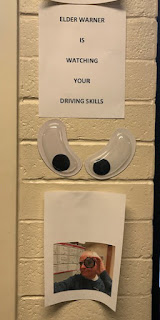The weeks roll by and we feel a little startled that we are
now approaching Thanksgiving. This past week
we marked the 6 months anniversary of our first day
as senior missionaries. Almost daily, we encounter
the challenges of our "temporary" assignments,
the concept of continuity and of handing off information
to the next folks to fill these positions.
It is difficult not to wonder at times if what we do will have
any lasting impact. Do the talents and experience we bring
make a difference? This has prompted some contemplation,
which in turn leads me to selecting this Thanksgiving theme.
Probably many of you know that 2020 will mark 400 years
since the "first" pilgrims landed at Plymouth Rock in 1620.
Many celebrations are being planned to mark that event.
Surely those arriving did not have the vision of what
their journey would contribute to - formation of a great nation.
Two weeks ago, we visited once again
the Joseph Smith Birthplace Memorial in
Sharon, Vermont, with the new missionaries and their
trainers as part of "Follow Up Training". Part of the
informational displays there at that site are genealogical,
informational displays there at that site are genealogical,
explaining the posterity of John Howland, a rather
unimportant (at the time) passenger who arrived
on the Mayflower. This story and the lineages from Howland
were referenced by Pres. Ballard when he spoke in
New England back in October.
This painting is "Howland Overboard," by maritime artist
Mike Haywood, artwork that is available from
the MayflowerHistory.com online store.
John Howland is the person near the lower right corner.
Howland was estimated to be around 20 years old when
he traveled aboard the Mayflower as the manservant of
Gov. John Carver. Quoting from the information that docents
there at the JSBM share, "During the Mayflower's voyage,
Howland fell overboard during a storm, and was almost
lost at sea -- but luckily for his millions of descendants
living today . . . he managed to grab hold of the topsail halyards,
giving the crew enough time to rescue him with a boat-hook."
Howland eventually married fellow Mayflower passenger
Elizabeth Tilley, who was 13 years old during the year
of the journey. The two could not be counted as
prominent passengers, but while the names and influence
of others may have dwindled (so many people died during
the first winters after the landing), these two can be traced
back to be the headwaters of dozens of very famous folks.
This signature, below, shown as "her mark" from the later years of
Elizabeth's life demonstrates that she could not write
even to sign her name. Definitely not among the elite.
Pres. Ballard connected the story of Howland overboard
to the family tree of Joseph Smith Jr., saying that
through generations, Heaven was watching out for the family
of the Prophet of the Restoration, even back during
the Mayflower voyage, since Howland is a progenitor of
the Prophet Joseph and also of Elder Ballard.
There at the JSBM emphasis is placed on the remarkable
nature of the "coincidence" and chance that allowed
the rescue line to be there, within his grasp,
at the moment of dire need.
This is a photo I could not resist including here,
simply because I took it, and now it can represent
the strong religious presence in the New England
towns which are part of the Pilgrims' legacy.
This photo was taken on Halloween, in Concord, MA.
Historians are quick to point out that the location of the landing
as Plymouth Rock was simply supposition that Americans
have latched onto and promoted, as well as other myths.
One was that religious freedom was the prime motivation,
though it may have been equally important to being able to make
a living without restriction, and establish their own ideal society.
Another myth is the idea that the pilgrims only wore
black clothing and were rather dull and one dimensional.
One historian's descriptions suggests they liked bright colors
and had lively activities and interests.
They also point out that the native Americans, including
the Algonquian people and the Wampanoag people
living here in the area, had already held harvest
celebrations here, so when we sing about
"that first Thanksgiving" feast, we are idealizing.
This will be the first Thanksgiving in a decade or so that
the Warner household has not hosted the celebration feast.
We have this year had our hearts warmed by the local LDS
congregations' attempts to make sure members and friends
all have a chance to feel the warmth of family on that day.
Many Wards or Stakes host a Thanksgiving potluck where
main elements of the traditional meal are provided,
with other fare being contributed by any who can
as they come and participate. (This might include us, too.)
As I think about people who take chances, make their actions
fit their proclamations of faith, contribute lives of meaning
without fanfare, or just by playing their parts,
the oil in my lamp is added to. Thankful for people in
our family trees who made this good life possible for us.
Happiest of Thanksgivings to friends and family.
















































